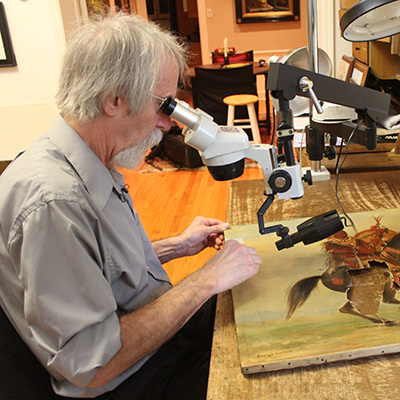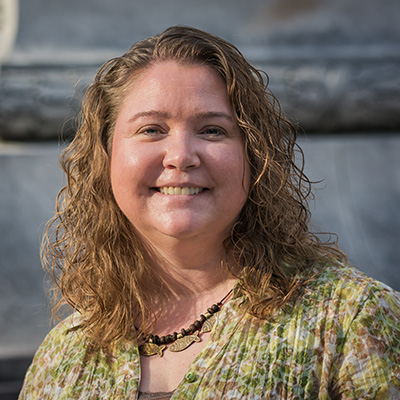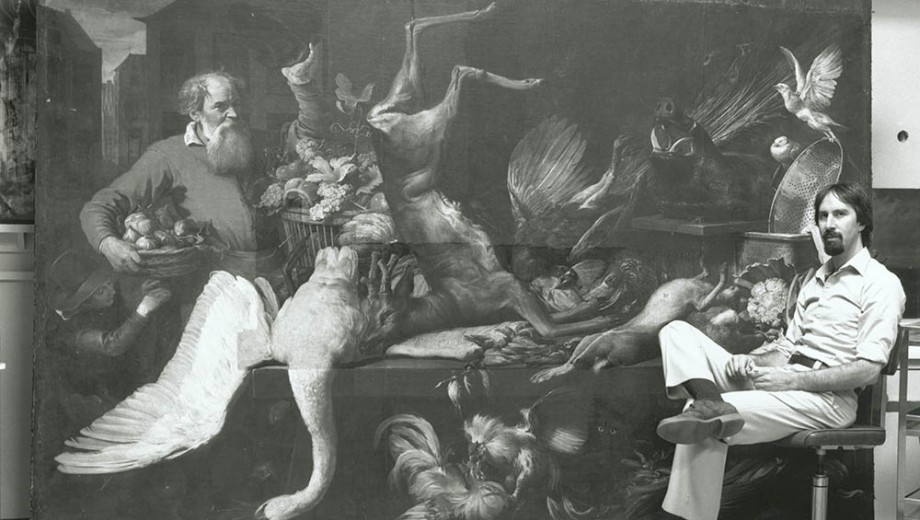Barry Bauman, AM’71, spent 11 years restoring paintings at the Art Institute of Chicago before starting his own conservation company, the Chicago Conservation Center. After selling the business, Bauman began donating his services to institutions across the country; he has restored more than 1,500 works of art free of charge since 2004.
 How did you first get interested in conservation?
How did you first get interested in conservation?
One of my professors at the U of C, Harold Haydon, LAB’26, PhB’30, AM’31, took his students to the conservation lab at the Art Institute as part of a behind-the-scenes look. I thought, well, this is pretty interesting—I’m looking at three Monets lying along the wall. Once I received my degree, I made an appointment to talk to the conservator at the Art Institute and told him I wanted to apprentice with him. He asked me for ten years of training. I told him I wasn’t doing anything for the next ten years, and that would be fine.
What is the training process for a conservator?
I didn’t even touch a painting for two years. I was learning other kinds of materials and techniques. The philosophy was that if you knew how to make something you would know how to fix it. I studied medieval painting techniques, egg tempera techniques, and Venetian techniques. I had to have a very clear understanding of how the old masters put their paintings together so that I would be able to know how to recreate that during conservation.
You have to have patience for what you’re doing. I’m a crazy man in a traffic jam, but when it comes to my work, don’t ever ask me if I’m done yet. I’m working on a painting that’s 350 years old, and if it takes me six months to work on it, it’ll just be 350-and-a-half when I’m done.
Do you ever feel intimidated when working on a priceless work of art?
If you were going to have an operation and you said to your doctor, “Are you scared to do this operation?” and he said, “Yes,” what would you do? You’d find another doctor.
It’s the same for me. This is what I’m trained to do.
**
Martha MacFarlane-Faes, AM’89, studied art history with a focus on architecture. Today she’s the deputy state historic preservation officer for Michigan’s State Historic Preservation Office.
When did you get interested in historic preservation?
My grandparents lived in a historic home on the Spencer-Peirce-Little Farm in Newbury, Massachusetts, which was built around 1690. It’s one of the oldest houses in America. I would spend all my summers there. It connected me to my family and to other generations, and I really enjoyed exploring it.
At UChicago I studied things related to preservation, but it wasn’t really called historic preservation. I was studying architecture and the policies and ideas surrounding why we build things the way we do and how we look at the past.
I was living in Michigan, and then along came this job opportunity at the State Historic Preservation Office—which I didn’t know much about. But I had the right skill set, and I thought, I’ll give it a try. It was more by good fortune and by accident than completely by intention that I found my way here.
What are you working on now?
It’s no secret we have some very distressed cities in Michigan—we call them legacy cities, post-industrial cities faced with a lot of blight. I’m frequently working with officials in Detroit and other communities to address how we deal with the historic fabric of the city, what we preserve and what we don’t, and how these communities are going to go forward in the future. This is an amazing issue of our time. These are very sad, real problems, but I’m excited I can part of the solution.
How has your work changed since you started?
When I started, people were abandoning cities right and left to go live in the suburbs. I see a bit of a reversal of that trend. Cities are becoming the dominant paradigm. Young people and even retirees want to be downtown and active. That is a huge change—and it tells me now we have much more of a market than we did for historic downtowns.
The amount of investment occurring in downtown Detroit in the last decade is staggering. The $33 million Merchant’s Row Project was one of the earlier ones, followed in 2008 by major redevelopments of two of our “white elephant” properties: the Book-Cadillac and Fort Shelby Hotels. Each of these developments involved close collaboration with our office to review plans and designs and ensure that appropriate preservation practices are followed. What’s exciting is that each of these big projects leverages millions more in job creation and local economic impact.
**
 Catherine Dewey, AM’97, left her studies in Egyptology to focus on architectural conservation. Now she works with the National Park Service as the chief of resource management for the National Mall and Memorial Parks in Washington, DC.
Catherine Dewey, AM’97, left her studies in Egyptology to focus on architectural conservation. Now she works with the National Park Service as the chief of resource management for the National Mall and Memorial Parks in Washington, DC.
What does architectural conservation entail?
It’s preserving structures using science. We look at, for instance, the type of stone and determine what mortar mix is best and most compatible. We look at a stain on a building and determine which chemicals might get that stain out, always making sure that we use the least aggressive method possible and testing in a discreet location.
What qualities make someone successful in the field?
Patience—what you think might work often may not. The ability to work with others—very rarely does someone in the world of preservation or architectural conservation work on their own. They’re often on a team. Flexibility—what you do might not always work. Perseverance—sometimes you have to educate colleagues and superiors as to why a project is taking longer than they would like or expect.
What is unique about working for the National Park Service?
My job is about preserving America’s special places for future generations, most importantly. We are leaders in the field of preservation—and look forward to the challenge of preserving these places. It’s a great organization to work for.


Add new comment